No matter where you are in the world, it is hard to talk about porcelain and not be reminded of one of the most famous household names of the porcelain manufacturing industry: Herend. Whether you are a neutral fan, an avid collector of the figurines or a novice about the brand, the name is so widespread that it is universally recognized as a carrier of the finest porcelain. In this week’s blog, we take a look at the not so successful beginnings of the company, as well as its gradual rise to top, making sure to include the reasons as to why exactly the brand is known as the finest of its kind today.
Rocky Beginnings
Despite the famous legacy of Herend as a manufacturer of fine porcelain today, it might come as somewhat of a surprise that it was first an earthenware pottery company in Herend, Hungary founded by Vince Stingl. The brand went bankrupt within its starting years due to a myriad of mismanagement concerns and it was soon overtaken by Mor Fischer, the creditor of the company. Fischer, a shrewd and ambitious man, started manufacturing artisanal porcelain in the same year, meeting the demand for classical porcelain dinner sets made in Europe and named the company after the city of its origin. The new porcelain sets were far more accessible than the porcelain of the Far East, the original supplier of fine china to Europe and thus, immediately met with a surging demand. Fischer’s real rise to fame came in 1849, when he began selling his wares to the Hungarian aristocracy.
A Royal Renaissance
Many mark the true fame of Herend as the time when it became the exclusive supplier of porcelain to royalty, which includes names such as Queen Victoria, Esterházy, Batthyány, Rothschild and Apponyi. The relationship with the royals extended to such lengths that in 1865, Francis Joseph I gave a noble title to Fischer, in appreciation of his work in porcelain art. From 1872 Mór Fischer Farkasházy, Purveyor to the Royal Court, was entitled to use the shapes and patterns of the revered Manufactory of Vienna, which had closed down.
Artistically credited, Herend displayed its designs at the First Hungarian Applied Art Exhibition, the Vienna Exhibition, the Great Exhibition in London, the Exhibition of the Industry of All Nations in New York and the Exposition Universelle in Paris. The styles became popular, and orders began to be received on behalf of several international royal courts: Queen Victoria, Francis Joseph I of Austria, Maximillian and the Mexican emperor.
The Magic of the Craft
Many might wonder why the pieces that are produced by Herend carry the price tags that they do. After all, the market is often swarmed with alternative, cheaper sources of porcelain makers. Besides the intensity of the crafting process, during which the illustrations and the patterns are hand- painted by a handful of artists, Herend products are made from hard-paste porcelain. The paste is created using a mixture of kaolin, feldspar and quartz, an atypical and labor intensive process that produces porcelain that is virtually indestructible and perfectly translucent. After cleaning, decorating and drying, the porcelain is first fired at 830 degrees Celsius, before being immersed in a glaze and fired again, this time at 1410 degrees Celsius. At this stage it is ready for painting by hand and depending on whether it has been painted with colors or with gold, it is finished off with one or two more firings. The brief video below chronicles the journey of a single Herend piece, from the making of the paste to the hand-painting process.
The result is the exquisite one of a kind pieces proudly carried by the brand.







Legacy and Awards
Herend porcelain has won 24 gold prizes in World Exhibitions between 1851 and 1937. One of the best known Herend patterns, a Chinoiserie set with butterflies and flowery branches painted in joyful and lively colors, won at the London World Exhibition in 1851. Soon after, Queen Victoria ordered this dinner set for the Windsor Castle., which is how the pattern came to be known as the “Viktória” set. The collection is still sold worldwide today and carries this rich heritage to every household destination.

The Herend Porcelain Manufactory was purveyor to the Habsburg Dynasty and the aristocracy, both in Hungary and abroad. The factory continues to manufacture porcelain according to the traditional methods, in order to produce a consistent quality. Today, Herend carries more than 4,000 unique patterns and while the range is inexhaustible, the company refuses to compromise on the artisanal talents of its workforce and the amount of attention paid to the quality of each product.
A purveyor of tradition, culture and quality, Herend continues to awe with its innovations and holdfast in a rapidly changing society, where quality is often undervalued.
